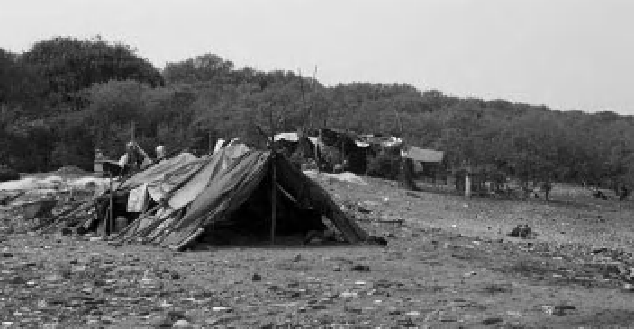Geoscience Reference
In-Depth Information
Figure 11-22.
Avicennia marina
(gray mangrove) appear in the background along with shanties that have built
illegally along a rocky shore in suburban Mumbai, India. If such settlements are allowed to persist unchecked,
residents may engage in illegally clearing mangroves for fuel wood and other materials. Photo by Firooza Pavri.
atmosphere from peatland clearing and its
future inl uence on climate change. Conversely,
benei cial externalities occur when, for instance,
an artii cial wetland is created primarily to treat
waste water, but also provides habitat to bird
and animal species, l ood protection, and carbon
sequestration services. Ecologists have argued
for the inclusion of externalities in any ecosys-
tem valuation exercise to rel ect the true total
costs and benei ts of any market exchanges of
resources or habitat alterations (Cutter and
Renwick 2004).
those affected by it. As Portney (2008) explained,
benei ts or gains are often measured by using
the “willingness to pay” principle, while the
costs or losses are calculated based on the
amount of compensation needed to offset nega-
tive consequences. Field and Field (2006, p. 116)
outlined the basic structure of a cost-benei t
analysis, which includes:
• Clearly identifying the issue or project.
• Identifying the different input and output
components.
• Calculating the benei ts and costs of these
components.
• Comparing and assessing the benei ts and
costs.
11.5.3 How to value wetlands?
Various approaches and methods have been
offered to assess the economic value of resources
such as wetlands. The most familiar of these is
cost-benei t analysis (CBA). Jules Dupuit pre-
sented this technique back in the nineteenth
century, and during the early twentieth century
it was used to evaluate large-scale hydro projects
in the United States. Since then, CBA has been
put to use in various i elds including transporta-
tion, public health, and the environment (Portney
2008). CBA provides a comparative assessment
of various alternatives, so that informed deci-
sions can be made before adopting resource
development strategies. As the name suggests,
this and other methods such as contingent-
evaluation (CV) techniques allow one to measure
the gains and losses of any proposed activity for
Cost-benei t analysis is most often measured in
quantii able economic terms. However, not all
benei ts or costs are so easily summarized. In
those cases, economists have devised ways to
assign shadow prices using proxy values or
replacement costs to enable quantii cation
(Cutter and Renwick 2004).
Researchers have pointed out problems
with using the cost-benei t approach to eco-
system valuations (Hanley and Spash 1995). For
instance, it is difi cult to assign monetary values
to ecosystem services such as nitrogen and
carbon storage. As this topic has indicated, eco-
system functions are complex and intercon-
nected. Changes to one system are bound to





